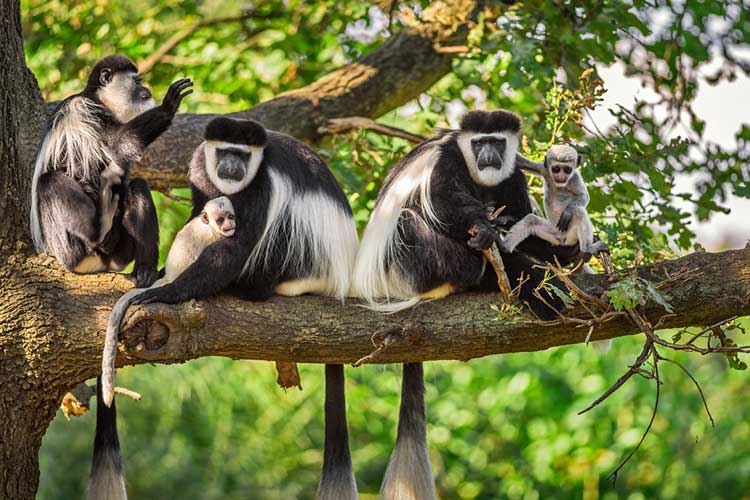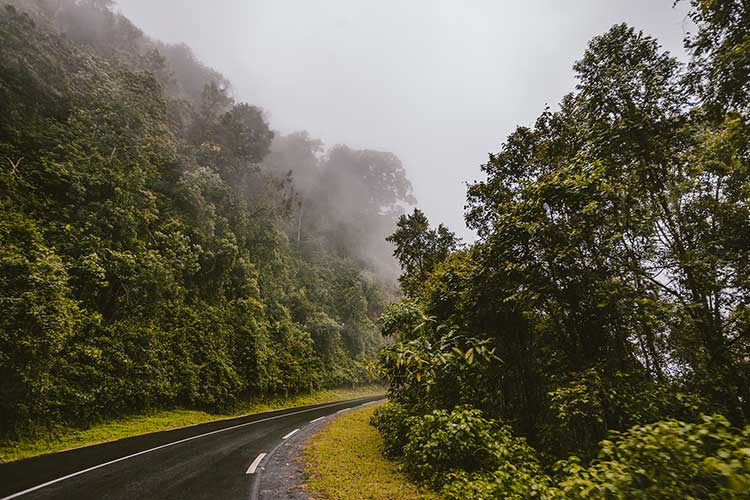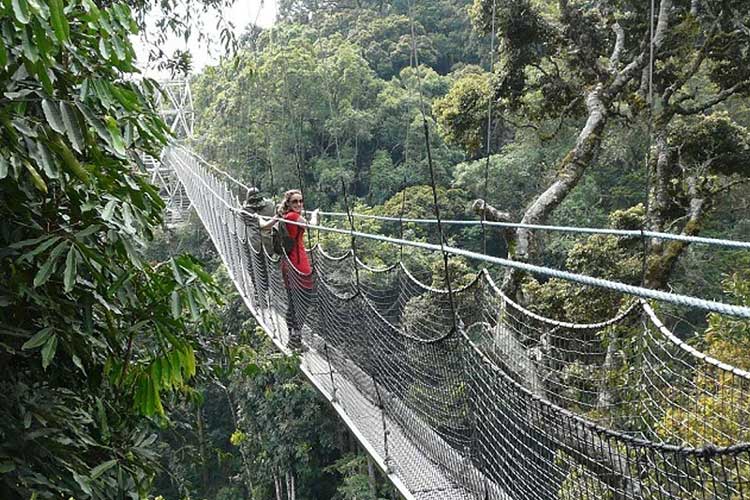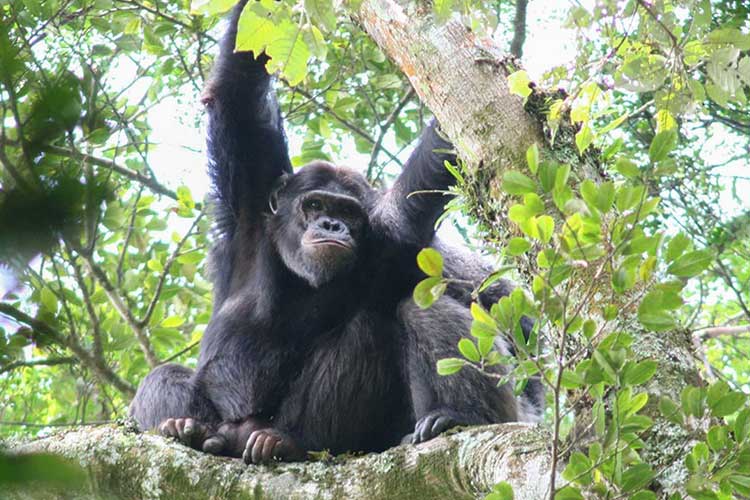Nyungwe Forest National Park is located in Southern Rwanda. With special activities: Like Waterfall in Nature, Chimpanzee, Canopy Walk & many more to See. This rainforest is probably the best-preserved mountain rain forest in Rwanda and Central Africa. Nyungwe is between the basin of the river Congo watersheds to the west and the basin of the river Nile to the east. From the east side of the Nyungwe forest comes also one of the branches of the Nile sources. Nyungwe Forest covers an area of 970 km2 of rainforest, bamboo, grassland, swamps, and bogs. The nearest town is Cyangugu, 54 km to the west. Mount Bigugu is located within the park borders.

With 13 primate species, 275 bird species, 1068 plant species, 85 mammal species, 32 amphibian and 38 reptile species, Nyungwe is worth a visit. Many of these animals are restricted-range species that are only found in the Albertine Rift montane forests ecoregion in Africa. The forest, has its highest altitude of 3000 meters above sea level, is of particular interest for the presence of colonies of chimpanzees and Angola colobus, the latter now extinct in Angola for the intense hunt to which they were subjected.

More about Nyungwe National Park
The common chimpanzee in Nyungwe are the robust chimpanzee closely related bonobo, formerly called the pygmy chimpanzee. Evidence from fossils and DNA sequencing shows both species of chimpanzees are the sister group to the modern human lineage. They are covered in coarse black hair, but has a bare face, fingers, toes, palms of the hands, and soles of the feet. It is considered more robust than the bonobo, weighing between 40 and 65 kg and measuring about 63 to 94 cm. Its gestation period is eight months, reaching puberty at the age of eight to 10 years, and its lifespan in captivity is about 50 years.
The common chimpanzee lives in groups of between 15 to 150 members, although individuals travel and forage in much smaller groups during the day. Nearly all chimpanzee populations have been recorded using tools, modifying sticks, rocks, grass, and leaves and using them for acquiring honey, termites, ants, nuts, and water.

L’Hoest’s monkey is another common specie of monkey that live in the Nyungwe Forest, closely related to the Hamlyn’s monkey in size and distribution. L’Hoest’s monkey is more closely related to the vervet monkeys of the genus Chlorocebus and the Patas monkey than to the other guenons of the genus Cercopithecus. L’Hoest’s has a short, dark brown coat, with a chestnut color across the back and a dark belly, with body length of 12.5 to 27 inches. The male weighs about 6 kilograms, while the smaller female weighs 3.5 kilograms.
Unlike the chimps, L’Hoest’s lives in fairly small groups dominated by females and have only a single male. The females are usually related, while the male stays only a couple of weeks or at most a couple of years. These primates are active during the day, mostly during early morning and late afternoon. They sleep in trees in a sitting position, usually either holding branches or each other.
L’Hoest’s monkey breed seasonally, with the timing depending on the area and this happens about a five month gestation period usually at the end of the dry season, which allows lactation when rainfall is highest. Male offspring reach sexual maturity they will leave the group. In captivity they have been known to live for more than 30 years.

Top Activities to do/see at Nyungwe National Park
Primate safaris in Nyungwe Forest
Nyungwe is an ideal destination for lovers of primates, with 13 different species living here, and most visitors will go for at least one tracking experience, the most popular of which is chimpanzee trekking. Starting very early in the morning, chimps are tracked in groups of eight and as with the mountain gorillas, you will have just one hour in their company once they’ve been located. Sightings aren’t as reliable or as clear as gorillas however, since they often remain in dense forest, but their engaging playfulness and human-like characteristics make the long day worthwhile.
Trekking in search of grey-cheeked mangabey and Rwenzori colobus monkeys is also on offer in Nyungwe Forest, the latter of which can be found here in troops of several hundred. And there’s no need to trek far to see l’Hoest’s monkeys – you will often see them ambling along the roadside as you drive past.

Forest hiking trails in Nyungwe
Over 130 kilometres of hiking routes have been created in Nyungwe Forest National Park, allowing visitors to explore its interior and its fascinating habitats. Walking in Nyungwe is excellent, with trails lasting from one to eight hours. The beautifully named Igishigishigi Trail is one of the shortest hikes yet includes East Africa’s highest canopy walk with spectacular views across Nyungwe Forest, while the 6 hour Bigugu Trail leads you to the highest mountain in the Park at 2950m.

Ngabwe Trail
This is also 4.7 kilometers and takes 3 hours to be completed and is moderately as regards to difficulty level. You will also find the trail taking you through much vegetation zones even though it’s a short trail. It can also be extended to be 8 hours long and would then include the Kitabi tea plantation. You are also free to carry packed lunch and eat at the picnic site that offers some good views of the forest. And along the trail, you will view the colobus monkeys, L’Hoest silver monkeys, chimpanzees as well as the Mangabey.
Birdwatching
This national park is found in the Albertine Rift valley eco- region and it’s very famous for its vegetation cover as well as being a home to many different bird species as compared to the other national parks. Nyungwe is also home to over 310 species of birds.
Though due to the fact that the forest is so dense, it can be so difficult to view the birds and most of them like to stay on top at the canopy more than the inside of the forest.in case you are on any birding safari, your guide will also help you in identifying the many different birds that you will see during the walk in the forest and also along the many different spots that they might know where the birds are normally seen. Some include; the Bigugu Mountain, having the canopy walk where you have a clear view of the canopy and a chance to view many birds at the top of the trees. There are also many other sites like Karamba area that is near Gisakura, the Kamiranzovu swamp as well as the gisakura tea estate and many more.

Chimpanzee Tracking in Nyungwe Forest
Nyungwe Forest National Park is also a good location where you can add chimpanzee trekking to your gorilla trek with in volcanoes national park without driving long distances. Chimpanzee trekking also starts in the morning and its best to carry a day pack where you have a couple of liters of water, have long trousers, the long sleeved shirt, rain jacket, the hiking boots and the hat. There will also be a maximum of over 8 people in your group that sets out to track the chimpanzees. These chimps at Nyungwe forest have been and are being habituated which means that they are used to human beings. Even though gorilla tracking, however, many set out to track these closest cousins as they play in Nyungwe forest national park.

Monkey Tracking
There are also over 13 primate species that are found in Nyungwe forest. There are also unconfirmed sightings of the golden monkeys that have also been reported.
